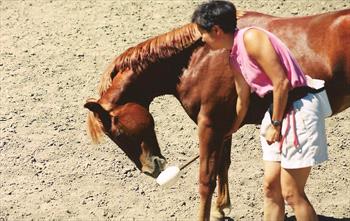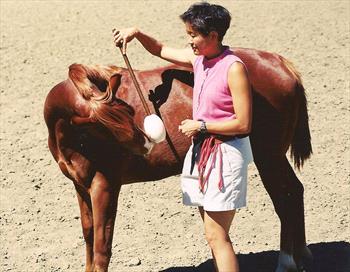Every year, the UC Davis Animal Science Department raises and sells yearling horses at their annual auction. While most owners would be happy if their yearlings could lead nicely on halter and load calmly into a trailer, in the Spring of 2000, when I was teaching the behavior courses in the Animal Science Department, I helped the students in charge of the yearlings aim higher. Using a combination of clicker training and natural horsemanship, we trained a number of handy behaviors.
One of the first things we taught was lateral and vertical bending. We taught the behaviors using two different techniques. The traditional natural horsemanship method for doing this is to use the halter or bridle to bend the horse laterally. When he relaxes into the bend you release the pressure so he knows exactly what he’s done right. The first couple of times you might just require he bend a little. Once he understands that relaxing his neck leads to pressure release and readily bends, you can increase the bend. Once the horse can bend laterally easily, you can add vertical bending, too, so that he learns to go “soft in the bridle.”
We taught the same body postures using positive reinforcement and a target stick too. We taught the yearlings to touch the target using their noses. Then we positioned the target in such a way that the yearling had to flex laterally or vertically to touch it. Given two techniques for training lateral and vertical bending, I’d probably prefer to teach it with positive reinforcement first, before I also taught the horse to respond to guidance with a lead rope or reins.
Target training is great for teaching horses to go to different places. We used the target when leading the yearlings towards objects that scared them. For instance, when Peewee (the little chestnut quarterhorse in the photo) was afraid of an unfamiliar object such as a bicycle laying on the side of the road, I placed the target a foot in front of her so she had to step toward the bike to touch the target and receive a food treat. I gradually moved the target closer to the object and rewarded her each time she touched the target. In this case it only took five minutes for her to feel comfortable enough to explore the bike.
In addition to target training, the yearlings learned to yield to pressure—to back up “in the bridle”—when we placed pressure on the halter, to back up when we placed pressure on the chest, and to step laterally or swing the haunches out when we applied pressure to the opposite side. Additionally, Peewee learned “turn on the forehand,” “turn on the haunches,” and lateral movement to hand cues without the use of physical pressure. She and the other yearlings willingly and enthusiastically performed the behaviors that we taught. These behaviors are important because it’s useful to be able to precisely position a horse. You may need to just move the front shoulder over two steps or have her back up straight and then turn the rear end left or right.
I also used targeting to train a come when called.
Clicker training and training with food works well when you need to train your horse for general husbandry procedures. We used clicker training to desensitize and counter-condition the yearlings that didn’t like having their ears, feet and mouths handled.
Yearlings that underwent this training quickly learned to stand quietly for foot-trimming and handling, ear clipping, and oral examination.





